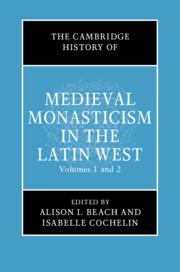Book contents
- The Cambridge History of Medieval Monasticism in the Latin WEST
- The New Cambridge History of Medieval Monasticism in the Latin West
- The Cambridge History of Medieval Monasticism in the Latin WEST
- Copyright page
- Contents
- Figures
- Contributors
- Acknowledgments
- Abbreviations
- 1 General Introduction
- Part I The Origins of Christian Monasticism to the Eighth Century
- Part II The Carolingians to the Eleventh Century
- 18 The Historiography of Central Medieval Western Monasticism
- 19 Sources for the History of Monasticism in the Central Middle Ages (c. 800–1100)
- 20 Questions of Monastic Identity in Medieval Southern Italy and Sicily (c. 500–1200)
- 21 Discerning “Reform” in Monastic Liturgy (c. 750–1050)
- 22 Monasticism, Reform, and Authority in the Carolingian Era
- 23 Carolingian Monastic Schools and Reform
- 24 Monastic Economics in the Carolingian Age
- 25 Missions on the Northern and Eastern Frontiers, c. 700–1100
- 26 Minsters and Monasticism in Anglo-Saxon England
- 27 Monastic Art and Architecture, c. 700–1100: Material and Immaterial Worlds
- 28 Monastic Daily Life (c. 750–1100): A Tight Community Shielded by an Outer Court
- 29 The Double Monastery as a Historiographical Problem (Fourth to Twelfth Century)
- 30 Interactions between Monks and the Lay Nobility (from the Carolingian Era through the Eleventh Century)
- 31 Monastic Reform from the Tenth to the Early Twelfth Century
- 32 Monastic Canon Law in the Tenth, Eleventh, and Twelfth Centuries
- 33 Eastern Influence on Western Monasticism, 850–1050
- Part III The Long Twelfth Century
- Part IV Forms of Monasticism in the Late Middle Ages
- Index
- References
33 - Eastern Influence on Western Monasticism, 850–1050
from Part II - The Carolingians to the Eleventh Century
Published online by Cambridge University Press: 16 January 2020
- The Cambridge History of Medieval Monasticism in the Latin WEST
- The New Cambridge History of Medieval Monasticism in the Latin West
- The Cambridge History of Medieval Monasticism in the Latin WEST
- Copyright page
- Contents
- Figures
- Contributors
- Acknowledgments
- Abbreviations
- 1 General Introduction
- Part I The Origins of Christian Monasticism to the Eighth Century
- Part II The Carolingians to the Eleventh Century
- 18 The Historiography of Central Medieval Western Monasticism
- 19 Sources for the History of Monasticism in the Central Middle Ages (c. 800–1100)
- 20 Questions of Monastic Identity in Medieval Southern Italy and Sicily (c. 500–1200)
- 21 Discerning “Reform” in Monastic Liturgy (c. 750–1050)
- 22 Monasticism, Reform, and Authority in the Carolingian Era
- 23 Carolingian Monastic Schools and Reform
- 24 Monastic Economics in the Carolingian Age
- 25 Missions on the Northern and Eastern Frontiers, c. 700–1100
- 26 Minsters and Monasticism in Anglo-Saxon England
- 27 Monastic Art and Architecture, c. 700–1100: Material and Immaterial Worlds
- 28 Monastic Daily Life (c. 750–1100): A Tight Community Shielded by an Outer Court
- 29 The Double Monastery as a Historiographical Problem (Fourth to Twelfth Century)
- 30 Interactions between Monks and the Lay Nobility (from the Carolingian Era through the Eleventh Century)
- 31 Monastic Reform from the Tenth to the Early Twelfth Century
- 32 Monastic Canon Law in the Tenth, Eleventh, and Twelfth Centuries
- 33 Eastern Influence on Western Monasticism, 850–1050
- Part III The Long Twelfth Century
- Part IV Forms of Monasticism in the Late Middle Ages
- Index
- References
Summary
In 980, Abbot Nilus of Rossano, who had lived nearly forty years of ascetic life in Greek southern Italy, prophesied new Muslim attacks and moved north. At Capua he was received “as if he were an apostle.” He visited Montecassino, invited by its refounder, Abbot Aligernus, and there all the monks, priests, and deacons of the community, arrayed in their festal robes, honored him with candles and incense “as if he were the great Anthony come from Alexandria or better the great Benedict … risen from the dead.” Nilus was given a monastery at Valleluce for himself and his sixty Greek-rite monks. On one occasion they celebrated their offices at Montecassino, impressing the audience with their liturgical good order as well as with a long Greek hymn that Nilus had written in praise of Benedict. About fifteen years later, Nilus moved even further north, ultimately founding the monastery of Grottaferrata near Rome, where he died in 1004.
- Type
- Chapter
- Information
- The Cambridge History of Medieval Monasticism in the Latin West , pp. 631 - 646Publisher: Cambridge University PressPrint publication year: 2020
References
- 1
- Cited by

